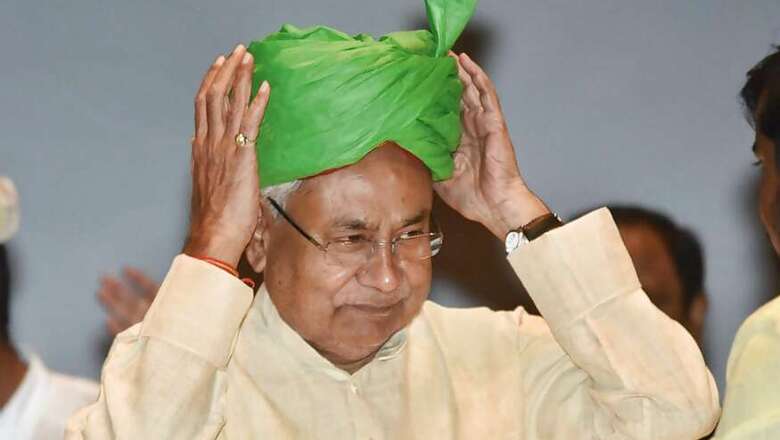
views
Patna: When BJP president Amit Shah announced his party’s decision to contest the same number of seats as ally Nitish Kumar’s JD(U), it sent shockwaves across the state leadership of the saffron party, which was anticipating an upper hand in seat-sharing.
The assumption of playing the role of ‘big brother’ stemmed from the fact that Kumar had dumped the ‘Mahagathbandhan’ led by the Congress and the RJD and returned to the NDA fold last year. It was bolstered after the Bharatiya Janata Party (BJP) won assembly elections in north-eastern states of Manipur, Tripura and Meghalaya.
The BJP juggernaut was eclipsing Kumar’s aura in Bihar as leader of the NDA coalition, which he enjoyed during the Vajpayee era for 17 years till 2013. It was then that he decided to join hands with his political rival Lalu Prasad Yadav after Narendra Modi was projected as the prime ministerial face of the NDA. The BJP was not willing to allow the Bihar chief minister to emerge as the leader of the coalition and pushed its own agenda in governance.
Even after the BJP’s shock defeat in the Phulpur and Gorakhpur Lok Sabha bypolls in March, the party’s state leadership was upbeat and tried to take ideological advantage of the Ramnavmi processions and subsequent communal tensions in at least 12 of Bihar’s 40 districts.
However, Kumar acted swiftly amid the hard-hitting attack by BJP hardliners and the state police arrested Union minister Ashwini Choubey’s son for fanning communal tension in Bhagalpur.
This was the first test for Kumar after he dumped Lalu Prasad, citing zero-tolerance against corruption. Publicly warning the BJP, Kumar said he would not compromise with his secular credentials. As the BJP stared at another debacle in Karnataka and UP’s Kairana, the Bihar chief minister and other state allies — Lok Janshakti Party’s Ram Vilas Paswan and Rashtriya Lok Samata Party’s Upendra Kushwaha — joined hands to exert pressure on the saffron party.
This is precisely what unfolded in April this year when the trio decided to bargain on seat-sharing for the 2019 Lok Sabha elections. The three leaders came up with the 20-20 formula, according to which the BJP would retain 20 seats and leave the remaining 20 for allies.
From April to July, when Shah met Kumar in Patna, the assumption was that the BJP would compromise on two of the 22 seats it won in 2014. On September 16, while addressing the JD(U) executive committee meeting in Patna, Kumar told his party men that a respectable deal had been sealed on seat-sharing, but refused to divulge the exact figures.
Even then, the state leadership of the BJP was under the impression that the party would continue to play the role of the dominant partner.
At its national executive meeting in Delhi, the JD(U) leadership, too, discussed the possibilities in a scenario where the party was still in a partnership with the RJD. The JD(U) came to the conclusion that even in that situation, it would have got fewer seats than Lalu Prasad’s party, which was the largest ally.
However, the changing political scenario after the Shah-Kumar meet gave the JD(U) the required platform to manoeuvre its tactics. The party not only upped its ante on the demand for special status to Bihar — a claim that saw Chandrababu Naidu leaving the NDA — but also asserted its independent views on Article 370, Ram Temple and Citizenship Act. The party leadership openly criticised the BJP on these issues and vowed not to compromise with its ideology.
The recent controversy over the Rafale deal was added advantage for the JD(U), giving the party bargaining power in the face of a full-frontal attack on the Modi government by the Rahul Gandhi-led Congress.
Though things seemed to be working for Kumar, the delay in formal talks on seat-sharing made the Bihar chief minister skeptical. It also put Kumar in an awkward position as he had, on July 14, announced that the seat-sharing formula would be made public within a month.
When the same did not happen, he started avoiding the media but kept hectic back-channel negotiations on in Delhi. One of the party's general secretaries played a crucial role in these parleys, using his connect with finance minister Arun Jaitley.
The invitation for unveiling the Sardar Patel statue in Gujarat on October 31 set the tone for the earlier announcement on seat-sharing as Kumar initially cancelled the meeting with state energy minister Saurabh Patel.
Patel was scheduled to visit Patna to invite Kumar for the event, which is being touted as a show of strength for the BJP-led NDA. Sensing trouble, the BJP leadership sent feelers to the Bihar CM, paving the way for Patel to meet him on October 22.
Kumar’s negotiators also reminded the BJP of the time when it was the junior partner and contested 15 seats, while the JD(U) fought on 25. The party stressed on the fact that when Kumar stitched the alliance with RJD in 2015, both contested equal number of seats, despite the fact that the JD(U) alone had 115 MLAs. In comparison, the BJP won only 53 seats in the 2015 elections.
These parleys then became the basis for the 50-50 seat-sharing formula announced by Shah and Kumar. When contacted, at least three BJP spokesmen and two state vice-presidents expressed shock over the settlement, while the JD(U) seemed pleasantly surprised as the party had won only two seats in 2014.
Though it may seem the BJP had to concede in the face of political compulsions, party leaders believe that the formula was agreed upon keeping in mind the 2020 polls and they could turn the tables in their favour if Modi returns to power in 2019.




















Comments
0 comment